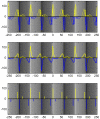Features and the 'primal sketch'
- PMID: 20696182
- PMCID: PMC4135077
- DOI: 10.1016/j.visres.2010.08.002
Features and the 'primal sketch'
Abstract
This review is concerned primarily with psychophysical and physiological evidence relevant to the question of the existence of spatial features or spatial primitives in human vision. The review will be almost exclusively confined to features defined in the luminance domain. The emphasis will be on the experimental and computational methods that have been used for revealing features, rather than on a detailed comparison between different models of feature extraction. Color and texture fall largely outside the scope of the review, though the principles may be similar. Stereo matching and motion matching are also largely excluded because they are covered in other contributions to this volume, although both have addressed the question of the spatial primitives involved in matching. Similarities between different psychophysically-based model will be emphasized rather than minor differences. All the models considered in the review are based on the extraction of directional spatial derivatives of the luminance profile, typically the first and second, but in one case the third order, and all have some form of non-linearity, be it rectification or thresholding.
Copyright © 2010 Elsevier Ltd. All rights reserved.
Figures







References
-
- Anstis SM. The perception of apparent movement. Philosophical Transactions of the Royal Society London. Series B, Biological Sciences. 1980;290:153–168. - PubMed
-
- Atkinson J, Campbell FW. The effect of phase on the perception of compound gratings. Vision Research. 1974;14(2):159–162. - PubMed
-
- Barth E, Zetzsche C, Rentschler I. Intrinsic two-dimensional features as textons. Journal of the Optical Society of America. A, Optics, Image Science, and Vision. 1998;15(7):1723–1732. - PubMed
-
- Bergen JR, Adelson EH. Early vision and texture perception. Nature. 1988;333(6171):363–364. - PubMed
-
- Blakemore C, Sutton P. Size adaptation: A new aftereffect. Science. 1969;166:245–247. - PubMed
Publication types
MeSH terms
Grants and funding
LinkOut - more resources
Full Text Sources

